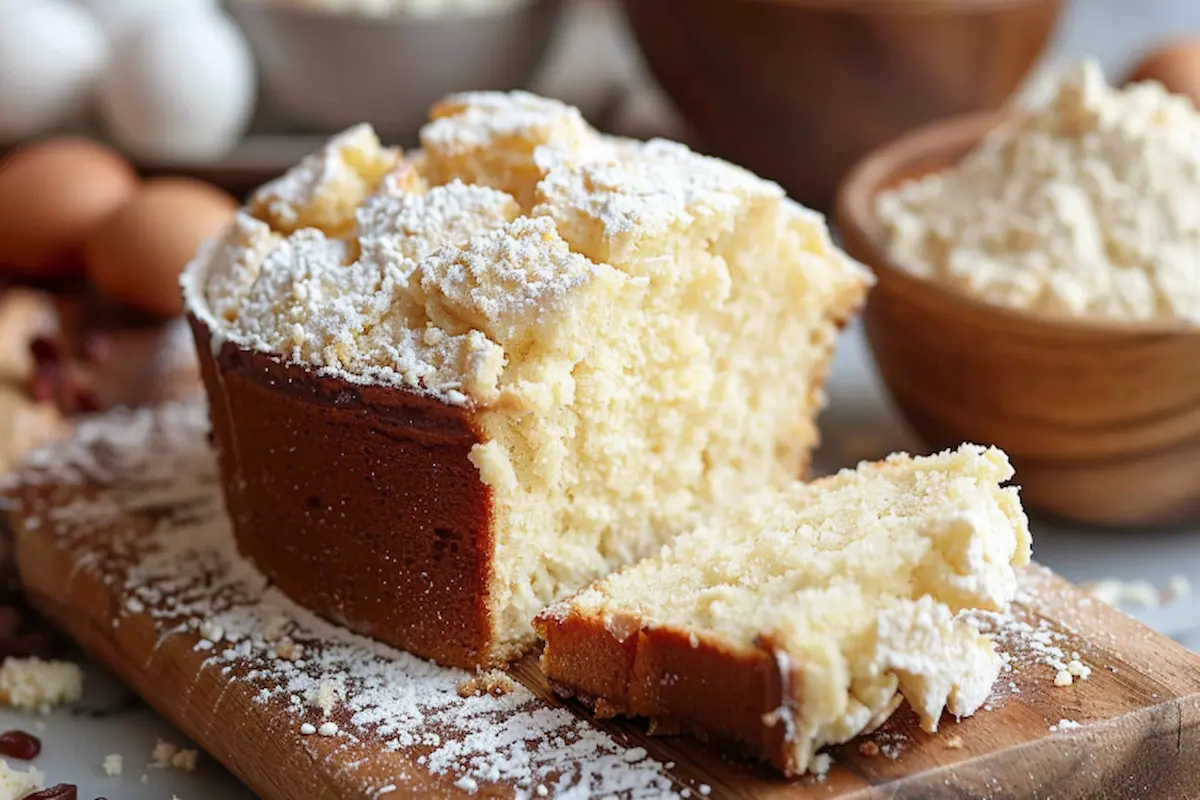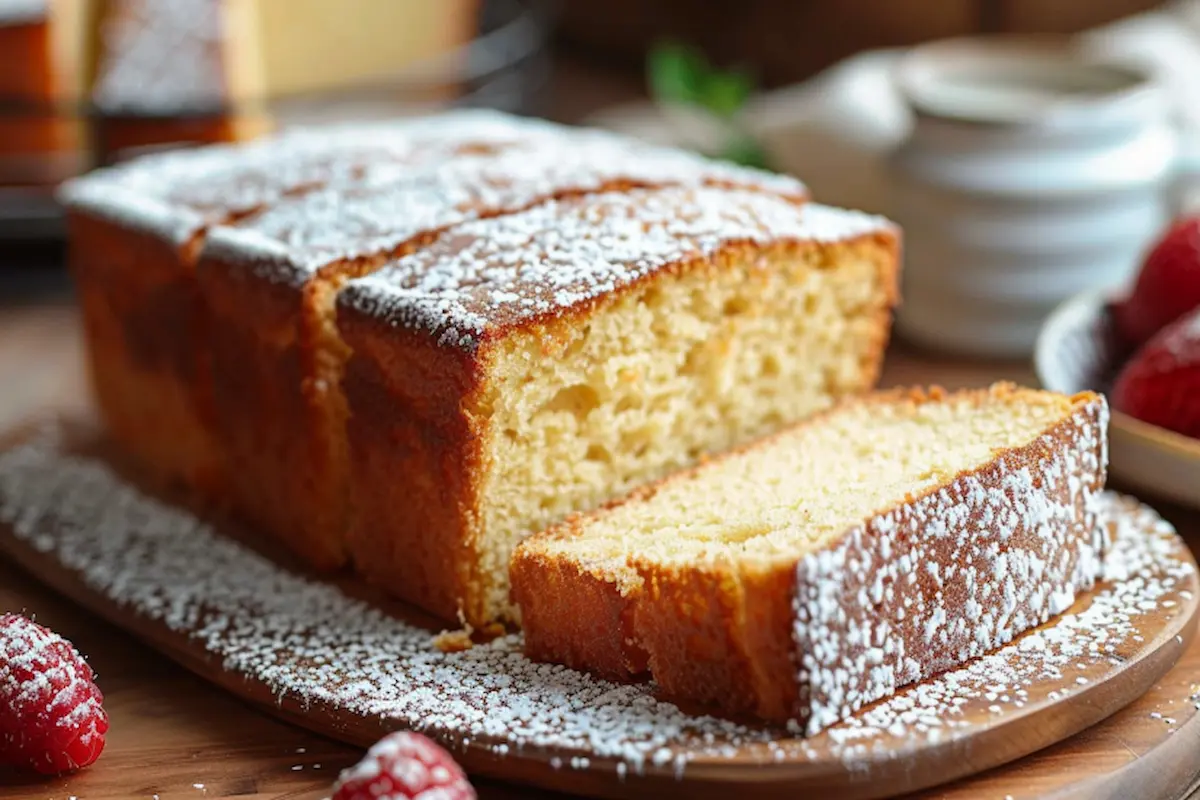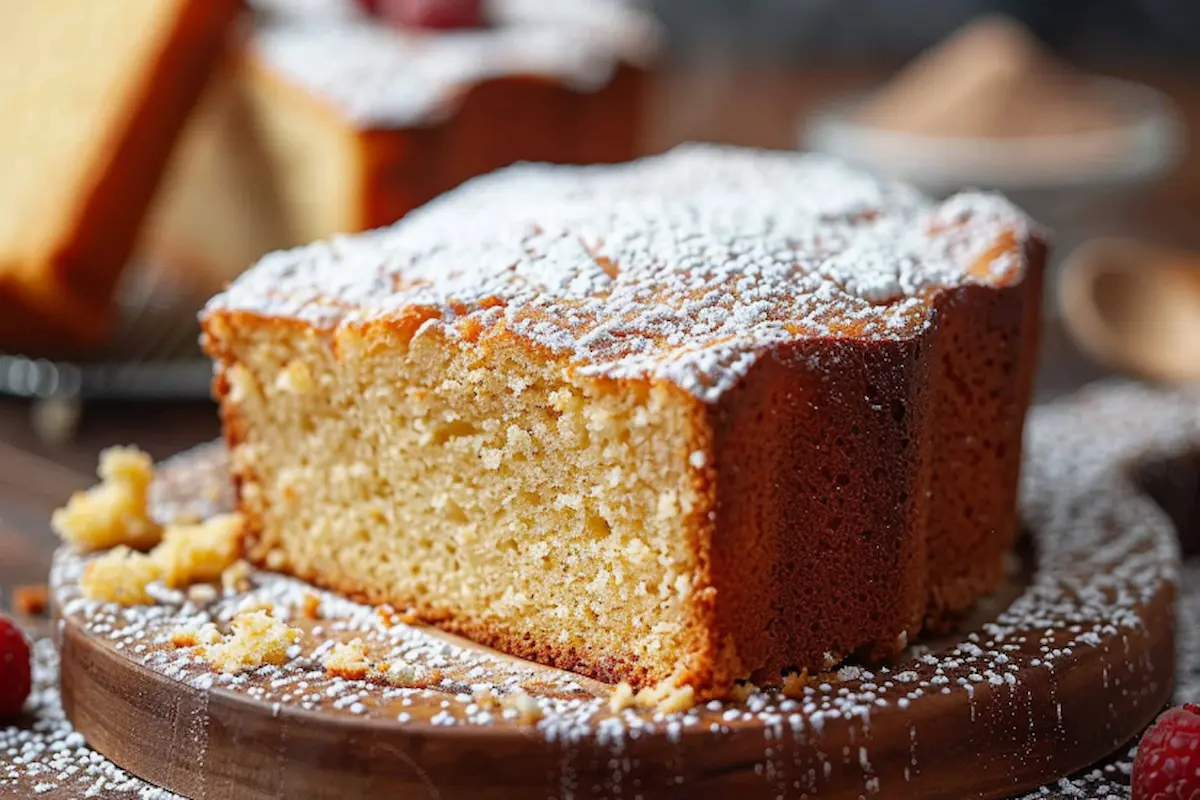Introduction: Why You Should Try Gluten-Free Pound Cake Recipe
Pound cake has long been a dessert staple, loved for its rich, buttery flavor and dense, satisfying texture. Traditionally made with equal parts flour, butter, sugar, and eggs, the classic pound cake may seem out of reach for those avoiding gluten. However, with the growing demand for gluten-free alternatives, adapting this beloved cake is easier than ever.
Whether you’re following a gluten-free diet due to gluten intolerance, celiac disease, or personal preference, you no longer need to sacrifice taste or texture. Gluten-free pound cake can be just as moist, buttery, and flavorful as its gluten-filled counterpart—with the right recipe, of course. In this guide, we’ll walk you through the process of making a flawless gluten-free pound cake that will quickly become a favorite in your baking repertoire.
Moreover, gluten-free baking opens up a world of possibilities, offering options that cater to both dietary needs and flavor preferences. With the increasing variety of gluten-free flours and baking techniques, creating a delicious gluten-free dessert has never been easier.
Whether you’re new to gluten-free baking or a seasoned pro, this comprehensive guide will help you master the art of making a perfect gluten-free pound cake. For those looking to expand their gluten-free baking journey, you may also find inspiration in other gluten-free recipes like Gluten-Free Desserts and Chickpea Pasta, offering a variety of delicious alternatives.

Why Choose Gluten-Free Pound Cake Recipe?
Going gluten-free doesn’t mean you have to miss out on classic desserts like pound cake. Whether you’re gluten intolerant, have celiac disease, or simply want to avoid gluten for health reasons, a gluten-free pound cake offers all the satisfaction of a traditional cake without the negative side effects. Gluten-free baking can sometimes feel intimidating, but with the right ingredients and techniques, you can create a moist, flavorful cake that even gluten-eaters will love.
For more on gluten-free baking, check out our guide on Gluten-Free Desserts: Delicious and Easy Recipes for Everyone, where you’ll find other tempting treats like cookies and brownies.
Essential Ingredients and Their Role
When it comes to baking, the ingredients you choose can make or break your cake, especially in gluten-free baking. Here’s a breakdown of what you’ll need for the perfect gluten-free pound cake:
1. Gluten-Free Flour Blend
The foundation of any gluten-free cake is the flour. You’ll need a high-quality gluten-free flour blend that contains a mix of rice flour, potato starch, and tapioca starch. Look for a blend that includes xanthan gum or guar gum, which helps bind the cake and gives it structure in the absence of gluten.
Want to learn more about gluten-free flour alternatives? Check out our article on Chickpea Pasta: A Nutritious, Gluten-Free Alternative for more gluten-free substitutions in cooking.
2. Butter
A pound cake wouldn’t be a pound cake without butter. Butter not only adds richness but also contributes to the cake’s moist texture. Opt for unsalted butter so you can control the amount of salt in the recipe.
3. Sugar
Granulated sugar is typically used in pound cakes to sweeten the batter and aid in the creaming process. For a deeper, more caramel-like flavor, you could substitute brown sugar or even coconut sugar.
4. Eggs
Eggs provide structure and help bind the ingredients. Make sure they’re at room temperature for the best results. Eggs also contribute to the cake’s light texture by trapping air when whipped with sugar.
5. Milk
You’ll need whole milk or a suitable substitute, like almond or coconut milk for a dairy-free version. Milk adds moisture and helps to create a tender crumb.
6. Vanilla Extract
A splash of vanilla extract brings warmth and enhances the sweetness of the cake. You could also experiment with almond or citrus extracts for a different flavor profile.
For a citrusy twist, you can add lemon or orange zest to the batter, similar to the fresh flavors in our Lemon Drizzle Cake recipe.
Step-by-Step Guide to Making Gluten-Free Pound Cake
Step 1: Prepare Your Pan and Preheat the Oven
Preheat your oven to 350°F (175°C). Grease a loaf pan with butter or non-stick spray and line the bottom with parchment paper. This ensures easy removal and prevents the cake from sticking.
Step 2: Cream Butter and Sugar
In a large mixing bowl, cream together the butter and sugar until light and fluffy, about 3-5 minutes. This step is crucial because it incorporates air into the batter, which helps the cake rise.
Step 3: Add Eggs
Beat in the eggs one at a time, making sure each egg is fully incorporated before adding the next. This gradual addition prevents the batter from curdling.
Step 4: Combine Dry Ingredients
In a separate bowl, whisk together the gluten-free flour, baking powder, and a pinch of salt. Gradually add this mixture to the wet ingredients, mixing on low speed.
Step 5: Add Milk and Vanilla Extract
Stir in the milk and vanilla extract until combined. Be careful not to overmix, as gluten-free batters can become gummy.
Step 6: Bake
Pour the batter into the prepared loaf pan. Smooth the top with a spatula, then bake for 50-60 minutes, or until a toothpick inserted into the center comes out clean.
Interested in more pound cake varieties? Check out our Buttermilk Pound Cake recipe for a southern twist on the classic.
Baking Tips for Success
- Accurate Measuring: Use a kitchen scale to measure your ingredients, especially the gluten-free flour, to ensure precision. Gluten-free flours can be tricky, and too much or too little can drastically affect the texture.
- Room Temperature Ingredients: Make sure your butter, eggs, and milk are all at room temperature before starting. Cold ingredients won’t mix properly and can result in a dense cake.
- Don’t Overmix: Gluten-free batters can become tough if overmixed. Stir just until the ingredients are combined.
- Check for Doneness: Test your cake with a toothpick or skewer. If it comes out clean, the cake is done. If it’s still gooey, give it another 5 minutes and test again.
For more general baking tips, see our article on the Ultimate Guide to Baking the Perfect Pineapple Upside-Down Cake.

Serving Suggestions for Every Occasion
One of the great things about pound cake is its versatility. Here are a few serving ideas to elevate your gluten-free pound cake:
- Classic Whipped Cream and Berries: Fresh berries like strawberries or raspberries paired with homemade whipped cream create a light, summery dessert.
- Citrus Glaze: A simple glaze made from powdered sugar and lemon juice can add a tangy twist to the richness of the cake. For inspiration, check out our Orange Olive Oil Cake for more citrusy flavors.
- Chocolate Ganache: A drizzle of dark chocolate ganache adds decadence. Melt dark chocolate and cream together, then pour it over the cake for a luxurious touch.
- Ice Cream: Serve your cake with a scoop of vanilla bean ice cream, or try a dairy-free option like coconut or almond milk ice cream.
For more dessert pairings, take a look at our recipe for the Ultimate Chocolate Peanut Butter Cookies for an indulgent combination.
Storing and Freezing Gluten-Free Pound Cake Recipe
To maintain freshness, it’s important to store your gluten-free pound cake properly:
Storing at Room Temperature
Wrap the cake tightly in plastic wrap or store it in an airtight container. It will stay fresh at room temperature for up to 3 days.
Freezing
For longer storage, freeze the cake. Wrap it tightly in plastic wrap and then in aluminum foil. Store it in a freezer-safe container for up to 3 months. When ready to serve, thaw the cake overnight in the refrigerator and bring it to room temperature before serving.
If you enjoy make-ahead desserts, consider our Frozen Oreo Cheesecake recipe, which freezes beautifully.
Frequently Asked Questions (FAQs)
1. Can I make this pound cake dairy-free?
Yes! Substitute the butter with a vegan butter alternative, and use almond milk or coconut milk in place of regular milk. The flavor will change slightly, but the texture will still be rich and moist.
2. Why is my pound cake dense?
A dense cake is often the result of overmixing the batter, which incorporates too much air. Mix the batter just until the ingredients are combined.
3. How can I add more flavor to my pound cake?
Add citrus zest, almond extract, or even a swirl of chocolate or jam into the batter before baking. For more inspiration, visit our guide on the Ultimate Guide to Baking a Chocolate Pound Cake.
Common Mistakes to Avoid {#common-mistakes}
- Not Sifting the Flour: Always sift your gluten-free flour blend to remove any lumps and ensure it mixes evenly into the batter.
- Skipping the Room Temperature Ingredients: Cold butter or eggs will not mix properly, leading to uneven texture in the cake.
- Overbaking: Gluten-free cakes can dry out more easily than traditional cakes. Keep a close eye on the bake time to avoid this.
Troubleshooting Your Gluten-Free Pound Cake {#troubleshooting}
If your gluten-free pound cake didn’t turn out as expected, don’t worry! Here are some troubleshooting tips:
- Dry Cake: This can happen if the cake was overbaked or if there wasn’t enough fat in the batter. Adding a tablespoon of sour cream or yogurt can help retain moisture.
- Soggy Cake: Make sure to check the cake’s doneness with a toothpick. If it’s still wet in the center, continue baking and cover the top with foil to prevent over-browning.
- Crumbly Texture: The lack of gluten can cause a cake to crumble. Ensure your flour blend contains xanthan or guar gum to help bind the cake.
Gluten-Free Pound Cake Recipe FAQs
1. What flour should I use for a gluten-free pound cake?
For a gluten-free pound cake, it’s best to use a gluten-free all-purpose flour blend. Look for one that contains a mix of rice flour, potato starch, and tapioca flour. Some blends also include xanthan gum, which helps improve texture. If your blend does not contain xanthan gum, you may need to add it separately.
2. Can I substitute almond or coconut flour in the recipe?
You can substitute almond or coconut flour, but it will change the texture and density of the cake. Almond flour gives a nutty flavor and a more dense, moist cake, while coconut flour absorbs more liquid, so you may need to adjust the wet ingredients to compensate.
3. How do I ensure my gluten-free pound cake doesn’t turn out dry?
To prevent dryness in gluten-free pound cakes, make sure you:
- Use enough fat, such as butter or oil, to keep the cake moist.
- Measure your flour properly; too much flour can lead to a dry cake.
- Avoid overbaking, as gluten-free baked goods tend to dry out faster.
4. Do I need to add xanthan gum or guar gum?
If your gluten-free flour blend does not already contain xanthan gum or guar gum, you’ll need to add about ½ teaspoon per cup of flour. These gums help provide structure and elasticity to gluten-free baked goods, which is normally provided by gluten.
5. Can I make this recipe dairy-free as well?
Yes, you can make a dairy-free version of the gluten-free pound cake by substituting butter with plant-based butter or margarine, and using non-dairy milk (such as almond, coconut, or oat milk) instead of dairy milk. The texture may vary slightly, but it will still be delicious.
6. How do I store a gluten-free pound cake?
Store the gluten-free pound cake in an airtight container at room temperature for up to 3 days. If you need to store it longer, refrigerate it for up to a week or freeze it for up to 3 months. Wrap the cake tightly in plastic wrap and then in aluminum foil before freezing to maintain its freshness.
7. Why did my pound cake sink in the middle?
There are a few possible reasons for this:
- The cake may not have been baked long enough. Make sure to check for doneness using a toothpick.
- Overmixing the batter can incorporate too much air, causing it to collapse as it cools.
- Opening the oven door too early can also cause the cake to sink as the temperature drop impacts the structure.
8. Can I add flavorings or mix-ins like lemon, vanilla, or chocolate chips?
Absolutely! You can add lemon zest, vanilla extract, or other flavorings to the batter to customize the flavor. Chocolate chips, berries, or nuts can also be folded into the batter, but toss them in a bit of gluten-free flour first to prevent them from sinking to the bottom of the cake.
9. How do I make the pound cake lighter and fluffier?
For a lighter pound cake, make sure to cream the butter and sugar well to incorporate air into the mixture. Additionally, using room temperature eggs and carefully folding in the flour can help create a lighter texture. Avoid overmixing once the flour is added to prevent a dense cake.
10. Can I use this recipe for cupcakes or other shapes?
Yes! You can use the gluten-free pound cake batter for cupcakes or even loaf cakes. For cupcakes, reduce the baking time to 18-22 minutes and keep an eye on them. If making in a loaf or bundt pan, adjust baking times accordingly and test for doneness with a toothpick.

Final Thoughts
Baking a Gluten-Free Pound Cake Recipe may seem daunting at first, but with the right ingredients, techniques, and a bit of patience, you can achieve a cake that’s every bit as delicious as its traditional counterpart. By using a high-quality gluten-free flour blend, ensuring your ingredients are at room temperature, and following the steps outlined in this guide, you’ll be rewarded with a moist, flavorful cake that’s perfect for any occasion.
Whether you serve it plain, topped with fresh fruit, or drizzled with a citrus glaze, gluten-free pound cake is a versatile dessert that caters to both dietary restrictions and the cravings of gluten-eaters alike. It’s a fantastic addition to any baker’s repertoire, offering endless customization options, from adding chocolate swirls to incorporating zesty lemon or orange flavors.
As you continue to explore the world of gluten-free baking, remember that practice makes perfect. Don’t be afraid to experiment with flavors, add different toppings, or even try incorporating new gluten-free flours. The journey to mastering gluten-free baking can be fun and rewarding.
For further inspiration, you might enjoy exploring more recipes like the indulgent Buttermilk Pound Cake or tangy Ultimate Key Lime Cake. Both offer unique twists on classic cakes that can be adapted to suit gluten-free diets.
With this guide in hand, you’re well-equipped to bake your next gluten-free masterpiece. Enjoy your gluten-free pound cake, and don’t hesitate to share the love with friends and family who might be surprised at just how good gluten-free baking can be. Happy baking!

